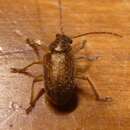pms
nòm ant ël fil


Eumolpini is a tribe of leaf beetles in the subfamily Eumolpinae. It is the largest tribe in the subfamily, with approximately 170 genera found worldwide. Members of the tribe almost always have a longitudinal median groove on the pygidium, which possibly helps to keep the elytra locked at rest. They also generally have a subglabrous body, as well as appendiculate pretarsal claws.[2][3]
Following the leaf beetle classification of Seeno and Wilcox (1982), the genera of Eumolpini are divided into five informal groups or "sections": Corynodites, Edusites, Endocephalites, Eumolpites and Iphimeites.[4]
In the Catalog of the leaf beetles of America North of Mexico, published in 2003, the section Myochroites of Bromiini was placed in synonymy with the section Iphimeites in Eumolpini. The North American genera Glyptoscelis and Myochrous from Myochroites were also transferred to Iphimeites.[5]
These 172 genera belong to the tribe Eumolpini:[6][7][8][9][10][11][12][13][14][15][16][17]
The genus Megascelis Latreille, 1825, which is traditionally placed in the tribe Megascelidini, is also included in the Eumolpini according to ITIS.[6]
Eumolpini is a tribe of leaf beetles in the subfamily Eumolpinae. It is the largest tribe in the subfamily, with approximately 170 genera found worldwide. Members of the tribe almost always have a longitudinal median groove on the pygidium, which possibly helps to keep the elytra locked at rest. They also generally have a subglabrous body, as well as appendiculate pretarsal claws.